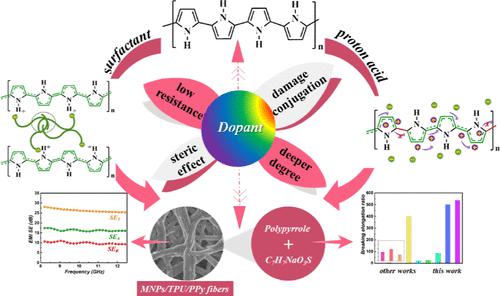当前位置:
X-MOL 学术
›
ACS Appl. Mater. Interfaces
›
论文详情
Our official English website, www.x-mol.net, welcomes your feedback! (Note: you will need to create a separate account there.)
Dopant Engineering of Flexible MNPs/TPU/PPy Core–Shell Films for Controllable Electromagnetic Interference Shielding
ACS Applied Materials & Interfaces ( IF 9.5 ) Pub Date : 2023-06-02 , DOI: 10.1021/acsami.3c02454 Wenxuan Zhao 1 , Biao Zhao 2 , Zhengchen Wu 1 , Ke Pei 1 , Yuetong Qian 1 , Kaicheng Luo 1 , Chunyang Xu 1 , Min Liu 1 , Min Wang 1 , Jincang Zhang 3 , Renchao Che 1, 3
ACS Applied Materials & Interfaces ( IF 9.5 ) Pub Date : 2023-06-02 , DOI: 10.1021/acsami.3c02454 Wenxuan Zhao 1 , Biao Zhao 2 , Zhengchen Wu 1 , Ke Pei 1 , Yuetong Qian 1 , Kaicheng Luo 1 , Chunyang Xu 1 , Min Liu 1 , Min Wang 1 , Jincang Zhang 3 , Renchao Che 1, 3
Affiliation

|
Intrinsically conductive polymers have attracted much attention in the electromagnetic interference (EMI) shielding field because of their high conductivity and favorable flexibility. Delocalized π-electrons migrating along the conjugated long-chain structures can form a current. Based on this special conductive mechanism, the doping process significantly influences the conductivity and EMI shielding efficiency (SE). However, it is challenging to investigate the influence of the doping process on EMI shielding performance, which would enable the optimization of dopant selection. In this study, dopant engineering was explored for controllable conductivity, EMI SE, and mechanical properties. Polypyrrole (PPy) doped with various dopants serves as a conductive coating owing to its adjustable conductivity and abundant functional groups. Elastic thermoplastic polyurethane was chosen as the porous framework because of its high tensile strength, and magnetic nanoparticles supplied the magnetic loss in the 3D network. Eventually, the composite film showed the best properties when PPy was doped with sodium p-toluenesulfonate. The film exhibited an average SE of 26.3 dB in the X band and a specific SE of 1563.17 dB cm2 g–1 with a thickness of merely 0.2 mm. This film withstood a tensile stress of 16.0 MPa, while the breaking elongation ratio reached 538.0%. After 10,000 cyclic bending, 92.3% of the EMI shielding property was retained. In summary, this study highlights the most suitable dopant for EMI shielding applications and provides a prospective alternative for advanced, flexible, and smart devices.
中文翻译:

用于可控电磁干扰屏蔽的柔性 MNPs/TPU/PPy 核壳膜的掺杂工程
由于其高导电性和良好的柔韧性,本征导电聚合物在电磁干扰(EMI)屏蔽领域引起了广泛关注。沿共轭长链结构迁移的离域 π 电子可以形成电流。基于这种特殊的导电机制,掺杂工艺会显着影响导电性和 EMI 屏蔽效率 (SE)。然而,研究掺杂工艺对 EMI 屏蔽性能的影响具有挑战性,这将能够优化掺杂剂的选择。在这项研究中,探索了掺杂工程以实现可控的电导率、EMI SE 和机械性能。掺杂各种掺杂剂的聚吡咯(PPy)由于其可调节的电导率和丰富的官能团而用作导电涂层。由于其高拉伸强度,弹性热塑性聚氨酯被选为多孔框架,磁性纳米粒子提供了 3D 网络中的磁损耗。最终,当PPy掺杂钠时,复合薄膜表现出最佳性能对甲苯磺酸盐。该薄膜在 X 波段的平均 SE 为 26.3 dB,特定 SE 为 1563.17 dB cm 2 g –1,厚度仅为 0.2 mm。该薄膜能承受16.0 MPa的拉应力,断裂伸长率达到538.0%。经过 10,000 次循环弯曲后,仍保留 92.3% 的 EMI 屏蔽性能。总之,本研究重点介绍了最适合 EMI 屏蔽应用的掺杂剂,并为先进、灵活和智能的设备提供了一种前瞻性的替代方案。
更新日期:2023-06-02
中文翻译:

用于可控电磁干扰屏蔽的柔性 MNPs/TPU/PPy 核壳膜的掺杂工程
由于其高导电性和良好的柔韧性,本征导电聚合物在电磁干扰(EMI)屏蔽领域引起了广泛关注。沿共轭长链结构迁移的离域 π 电子可以形成电流。基于这种特殊的导电机制,掺杂工艺会显着影响导电性和 EMI 屏蔽效率 (SE)。然而,研究掺杂工艺对 EMI 屏蔽性能的影响具有挑战性,这将能够优化掺杂剂的选择。在这项研究中,探索了掺杂工程以实现可控的电导率、EMI SE 和机械性能。掺杂各种掺杂剂的聚吡咯(PPy)由于其可调节的电导率和丰富的官能团而用作导电涂层。由于其高拉伸强度,弹性热塑性聚氨酯被选为多孔框架,磁性纳米粒子提供了 3D 网络中的磁损耗。最终,当PPy掺杂钠时,复合薄膜表现出最佳性能对甲苯磺酸盐。该薄膜在 X 波段的平均 SE 为 26.3 dB,特定 SE 为 1563.17 dB cm 2 g –1,厚度仅为 0.2 mm。该薄膜能承受16.0 MPa的拉应力,断裂伸长率达到538.0%。经过 10,000 次循环弯曲后,仍保留 92.3% 的 EMI 屏蔽性能。总之,本研究重点介绍了最适合 EMI 屏蔽应用的掺杂剂,并为先进、灵活和智能的设备提供了一种前瞻性的替代方案。



























 京公网安备 11010802027423号
京公网安备 11010802027423号